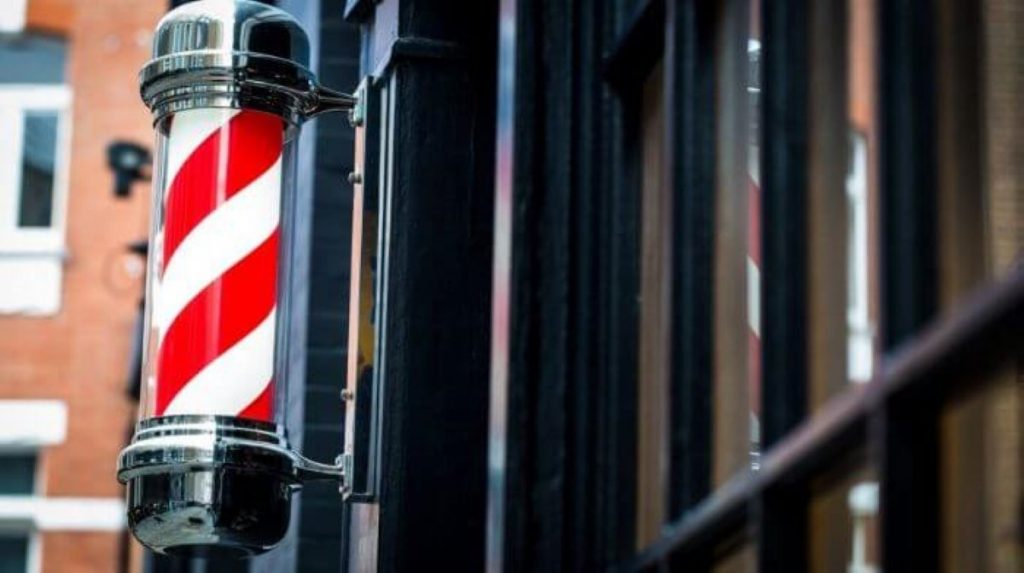Why Barber’s Poles Have All Those Stripes

Pictured above is the outside of a barber shop. You know that’s the case because of the short little pole on the outside of the building — it’s called a “barber’s pole.” In Europe., they’re typically red and white striped; in parts of the U.S., you’ll often also see a blue stripe added. It’s a great example of marketing — this little symbol, absent any words or letters of any kind, tells passersby from multiple cultures that, if they need a shave or a haircut, this is the place you want to be.
But the barber’s pole is also a very strange way to communicate “get your haircut here!” to those in the area. An image of scissors, maybe a comb, or perhaps a shaving razor? Sure, those would make sense. But something that looks like a chunk of a candy cane? What’s going on here?
The answer: for centuries, barbers have cut hair. But go back a bit further than that, and hair wasn’t the only thing that they cut.
Barbershops — or barbers, at least — have as been around for millennia, dating back to at ancient Egypt. And over the course of human history, haircuts have been part of cultural, hygienic, and even religious practices. Getting your hair cut isn’t usually dangerous, despite the fears of toddlers sitting in that barber’s chair for the very first time, but it still involves allowing someone to take a sharp object very close to your skin. Even today, an errant slip of the barber’s shears can lead to a bloody accident.
That’s a bad thing, but it also meant that early barbers — particularly when using tools that wouldn’t be acceptable today — had to know what to do when the inevitable accident occurred. And about a thousand years ago, that created an opportunity for the professional haircutters out there. As History explains, “during the Middle Ages bloodletting, which involves cutting open a vein and allowing blood to drain, was a common treatment for a wide range of maladies, from sore throat to plague. Monks, who often cared for the sick, performed the procedure, and barbers, given their skill with sharp instruments, sometimes provided assistance.” But in the year 1163, per History, monks had to get out of this line of work, as Pope Alexander “prohibited clergymen from carrying out the procedure.”
The barbers, though, weren’t bound by that papal decree. So they not only continued to offer the bloodletting service, they expanded upon it. According to Mental Floss, “early physicians thought of some surgeries as being beneath them, so the tasks of mending wounds, bloodletting, and extracting teeth fell to barbers. For their dual roles of cutting hair and cutting veins, they were called barber-surgeons and later, when the Collège de Saint-Côme in Paris wanted to further distinguish between academic surgeons and barber-surgeons, ‘surgeons of the short robe.'”
But bloodletting and barbershop surgery is a messy trade, and no one wants blood-soaked bandages all over the barbershop floor. The solution was to take that mess outside. According to the Farmers’ Almanac, patients of barber-surgeons “would grip [a stick] in order to make the veins of their arms stand out,” and after the bloodletting was done, the” barber-surgeons would wash the bandages (though they were usually still bloodstained), wrap them around the staff, and place them outside to dry.” The red-stained white bandage, all wrapped across a short staff, became a symbol that inside, there was someone available to cut your hair and drain your blood, all for one low fee.
The modern barber poles come from that practice. The white symbolizes bandages, the red comes from the blood from those undergoing surgeries of some sort, and the shape of the pole comes from the stick patients would squeeze so that barbers could find a vein. The blue stripe on barber poles common in the United States is either because veins are seen as blue from outside of your skin, or as a show of American patriotism, no one knows for sure.
Today, the symbol is nearly universally anachronistic. Most places have laws regulating where surgeries can be performed, and barbershops most definitely are not acceptable venues.
Bonus fact: As lots of shampoo brands tell us, some people have “oily” hair. That’s because our hair is pretty good at absorbing oil — which, cosmetically speaking, can be bad. But environmentally speaking, that can be good, particularly when there’s a disaster. In 2010, a nonprofit collected “hundreds of thousands of pounds of hair” from barbershop floors and sent them to the Gulf of Mexico to help aid in the cleanup from an oil spill; per USA Today, “a pound of hair can absorb one quart of oil in one minute, and hair mats can be wrung out and reused up to 100 times,” making human hair mats one of the better ways to clean up such messes.
From the Archives: A Hair-Brained Rule: North Korean has acceptable haircut guidelines, and they’re not very flexible.
